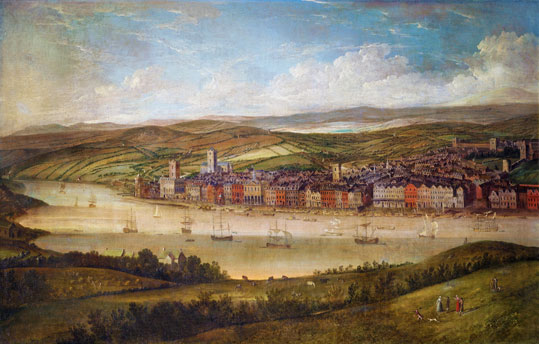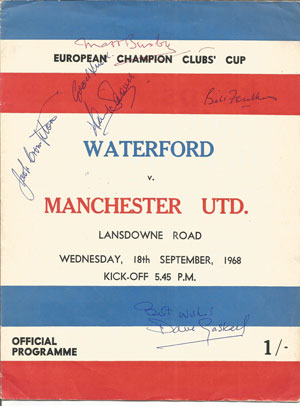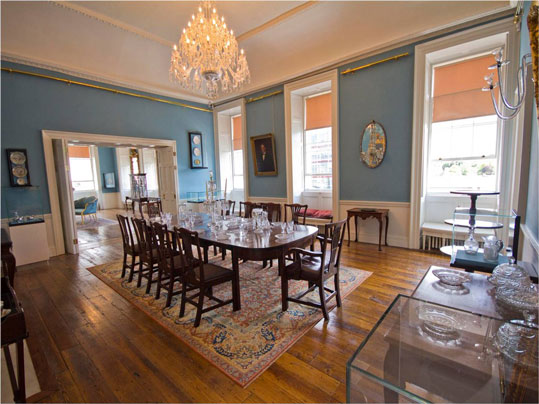THE BISHOP’S PALACE, WATERFORD
Published in Issue 1 (January/February 2023), Reviews, Volume 31www.waterfordtreasures.com/bishops-palace
By Donal Fallon
It is a sad reality that the Irish capital, at present, has no official civic museum. Readers may recall the former Civic Museum on South William Street, a treasure trove of Dublin relics. A journey through it introduced the visitor to everything from the bullet-ridden head of Horatio Nelson (Thomas Kirk’s statue, that is, which once stood on top of the Pillar) to the imaginary Colt 45 of Thomas Dudley, affectionately known to generations as ‘Bang Bang’. Dudley would traverse the city streets staging mock shoot-outs with a key in hand, something that history, thankfully, felt worth preserving.
Waterford has no such problems. In a fine district, collectively known as ‘Waterford Treasures’, there are no fewer than five museums that explore the history of Ireland’s oldest city. The Bishop’s Palace, formerly the home of Waterford’s Church of Ireland bishops and connected to the architect Richard Cassels, is a beautiful Georgian building that tells a much broader story than just that of the eighteenth century. While two floors of the building are presented as a Georgian home space, a journey through the building introduces the visitor to historic Waterford industries, the revolutionary period and a surprising array of social history exhibitions.
Before entering the museum itself, the grounds around it are worthy of exploration, hosting an array of historical monuments with civic connections. These include a memorial to the Waterford men of the International Brigades who participated in the Spanish Civil War (the recently departed Liam Cahill noted it to be the first such memorial from an Irish local authority) and a striking 1916 centenary memorial depicting the Proclamation within a fine stainless-steel frame.
On entering the Bishop’s Palace, a space on the ground floor provides a workspace and gallery to Seán Egan, a former master engraver with Waterford Crystal for 35 years. Egan’s work is internationally recognised, including the shamrock bowl commissioned by the Department of An Taoiseach for the annual St Patrick’s Day ceremony in the White House. For visitors to Waterford the story of Waterford Crystal is a central attraction, but the relationship of the city to the historic brand is complex, owing to most of its output now being produced abroad since the acquisition of the firm by the global Fiskars Corporation in 2015. Egan’s studio is a reminder that there is still top-class crystal from Waterford being produced here. Works on display include his glass tribute to the New York Fire Department’s Chaplain Mychal Judge, who perished in the 9/11 attacks, and a moving memorial to the local Collins family, six siblings who all served in the First World War. On other days we might have encountered a demonstration in this space, but it’s still fascinating to see the tools of the trade.

Above: William Van der Hagen’s landscape view of Waterford, the first landscape painting of an Irish city, commissioned by Waterford Corporation in 1736.
Climbing the stairs, we are treated to rooms of Georgian furniture, paintings and decorative mirrors. On display is William Van der Hagen’s landscape view of Waterford, commissioned by Waterford Corporation in 1736 for the princely sum of £20. The first landscape painting of an Irish city, Van der Hagen’s work captures the quays of the eighteenth-century city. Another eighteenth-century item is one of the oldest surviving pieces of Waterford-produced crystal, the Penrose Decanter from 1789. In the same decade that this piece was produced, the Penrose family glassworks was boasting of an ability to produce flint glass of ‘as fine a quality as any in Europe’.
The upper floor of the Bishop’s Palace hosts a wandering social history exhibition that transforms the museum into an exploration of more recent and remembered decades in Waterford’s past. A room exploring the showband scene was an unexpected digression into an important and transformative youth culture, including oral history. ‘It would be a mortal sin if a fella came in tipsy—the girls wouldn’t go for him. But the Pioneers were in great demand’, we’re told by one female dancer. Items on display include posters for the iconic Royal Showband, and the hucklebuck shoes of front man Brendan Bowyer are a centrepiece that would be fitting in any museum of Irish youth culture. Vincent Power’s wonderfully titled Send ’em home sweatin’: the Irish showband story remains a ‘must read’ for anyone wishing to understand a time when Irish youth went from dancing at the crossroads to dancing in ballrooms.

Above: Cover of the programme for Waterford v. Manchester United at Lansdowne Road, 18 September 1968.
The newest addition to the Bishop’s Palace is the Waterford Sporting Heroes room, exploring the sporting heroes of the Déise through decades (featured in Bite-sized History in Sept./Oct. 2022). A lesser-known name is ‘Wild Man from Borneo’, a hero on four legs at the Aintree Grand National in 1895, but more familiar are the Waterford United side who took on Manchester United at a packed Lansdowne Road in 1968, and items relating to iconic Déise hurlers Jim Ware and Frank Walsh. Refreshingly, the exhibition offers inspiration to young visitors by highlighting contemporary female stars, like Ladies’ Gaelic Football All-Ireland winners and Irish soccer international Ciara Grant.
The idea of a museum that encompasses eighteenth-century crystal and Brendan Bowyer’s dancing shoes may seem peculiar. Are museums spaces for particular narratives, increasing our understanding of a specific theme or subject in the past? Or can they be something much broader? The Bishop’s Palace seeks to give a potted history of Ireland’s oldest city and does so in a way that utilises everything from architectural history to sports history, and from social history to labour history.
Donal Fallon is the presenter of the Three Castles Burning podcast and the author of Three Castles Burning: a history of Dublin in twelve streets (New Island, 2022).

















